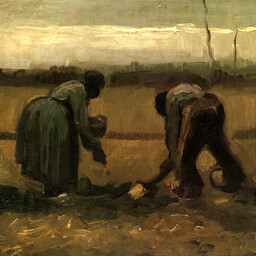Eestis on palju vanasõnu töö kohta. Näiteks "töö tegi ahvist inimese". See näitab sundtööd. On ka ütlusi, mis kiidavad tööd, nagu "töö kiidab tegijat".
Paljud vanasõnad on pärit talupoegadelt. Näiteks "töö ei lõppe kunagi" ja "töö on lolli ajaviide". Töö eest peab saama tasu, nagu öeldakse "tühi kott ei seisa püsti".
Inimesed jagunevad töö suhtes kolmeks. Mõned teevad tööd elamiseks, teised eneseteostuseks. Kolmandad püüavad tööd vältida. Eestis töötab 69% inimestest elamiseks, ainult 16% elab töötamiseks.
Varem oli töö hooajaline. Sügisel tehti palju tööd, talvel vähem.
Tööaeg reguleeriti
20. sajandil. Enne seda töötati kaua, näteks 11,5 tundi päevas.
Tööaeg reguleeriti
Tõlge fraasile: Tööaeg reguleeriti
EN
Working hours were regulated
Naiste ja meeste palgad olid erinevad
. 1875. aastal sai sulane üle 15 rubla, aga teenijatüdruk ainult 7,5 rubla. Tänapäeval on vahe väiksem, kuid see on endiselt probleem.
Naiste ja meeste palgad olid erinevad
Tõlge fraasile: Naiste ja meeste palgad olid erinevad
EN
Men's and women's wages were different
Tänapäeval on töö mitmekesine
. Inimesed otsivad eneseteostust.
Uued trendid on lühem töönädal
ja tehisaru.
Neljapäevane töönädal
on mõnes ettevõttes edukas.
Tehisaru muudab palju töökohti
, eriti madalama palgaga ametid.
Tänapäeval on töö mitmekesine
Tõlge fraasile: Tänapäeval on töö mitmekesine
EN
Today, work is diverse
Uued trendid on lühem töönädal
Tõlge fraasile: Uued trendid on lühem töönädal
EN
New trends include a shorter workweek
Neljapäevane töönädal
Tõlge fraasile: Neljapäevane töönädal
EN
Four-day workweek
Tehisaru muudab palju töökohti
Tõlge fraasile: Tehisaru muudab palju töökohti
EN
Artificial intelligence is changing many jobs
In Estonia, there are many proverbs about work. For example, "work turned a monkey into a human." This demonstrates forced labor. There are also sayings that praise work, such as "work praises the doer."
Many proverbs come from peasants. For example, "work never ends" and "work is the fool's pastime." Work must be rewarded, as they say, "an empty sack cannot stand upright."
People are divided into three categories regarding work. Some work to live, others for self-fulfillment. The third group tries to avoid work. In Estonia, 69% of people work to live, while only 16% live to work.
In the past, work was seasonal. A lot of work was done in autumn, less in winter. Working hours were regulated in the 20th century. Before that, people worked long hours, for example, 11.5 hours a day.
Women's and men's wages were different. In 1875, a farmhand received over 15 rubles, while a maid received only 7.5 rubles. Today, the gap is smaller, but it remains a problem.
Today, work is diverse. People seek self-fulfillment. New trends include a shorter work week and artificial intelligence. A four-day work week has been successful in some companies. Artificial intelligence is changing many jobs, especially those with lower wages.

